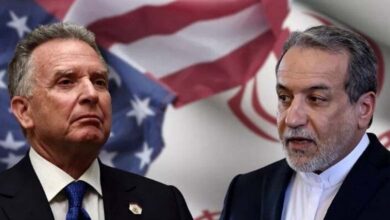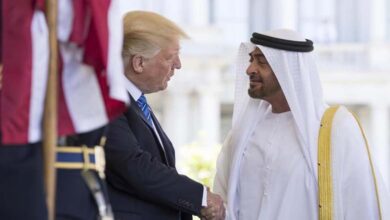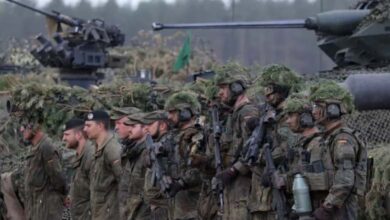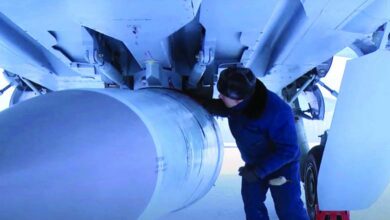From Brooms to Tanks: The Return of Europe’s Largest Military Power

Confronted with rising threats and growing anxiety over the Ukrainian crisis, Germany’s military machine is being reborn, emerging once again as a force to be reckoned with in Europe.
Once hesitant to spend on defense, Germany has transformed into a major European power rebuilding its military capabilities at a pace unseen since the Cold War. This dramatic shift stems from an increasing Russian threat and the declining reliability of the American security umbrella, according to The Telegraph.
-
UK Reinforces Its Defenses with Nuclear Submarines: Largest Military Overhaul Since the 1990s
-
U-Boats: Germany’s Terrifying Weapon That Changed the Course of War
Just a decade ago, Germany’s army was mocked during NATO exercises when soldiers had to use black-painted broomsticks instead of rifles due to severe equipment shortages — a symbolic image of decades of neglect and complacency.
Driven by the belief that Europe had entered an era of lasting peace, Berlin drastically reduced its military spending after the Cold War, constrained by its historical aversion to militarism and the trauma of its Nazi past.
The 2022 invasion of Ukraine changed everything. Germany, like much of Europe, was shocked by the return of war to the continent and realized that dialogue and trade alone could no longer deter Moscow.
-
Europe’s drone wall… Germany exposes the gaps
-
Doomsday Weapons: Who Owns Them and Where Are They Stored?
In his “historic turning point” speech, former Chancellor Olaf Scholz vowed to build “a modern, reliable army capable of protecting Europe,” launching a €100 billion special fund to modernize the Bundeswehr.
The real transformation, however, has taken place under current Chancellor Friedrich Merz, who lifted constitutional restrictions on defense spending and authorized massive borrowing to fund rearmament. With this policy, Germany can now spend hundreds of billions on military equipment, surpassing the combined defense investments of Britain, France, and Poland.
According to Merz’s plan, defense spending will rise to 3.5% of GDP by 2029 — six years ahead of Britain’s target. The defense budget, currently around €86 billion, is expected to exceed €160 billion by the end of the decade.
-
German Army Preparing to Develop Long-Range Combat Drones
-
Ukraine’s Patriot and Russian Sanctions: A Decisive U.S. Move or a Trial of Frontlines?
The stated goal is to make the Bundeswehr the strongest conventional army in Europe and a cornerstone of NATO’s defense structure.
This shift reflects a growing German realization that the United States is no longer a guaranteed protector. President Donald Trump’s renewed demand for NATO members to raise defense spending to 5% of GDP — accusing allies of “free-riding” — reinforced that perception.
Merz has declared that “Washington no longer cares about Europe’s fate,” emphasizing the need for true strategic independence.
-
Nautilus: The American Beast That Wages War Beneath the Waves
-
From Simplicity to Smart Armor: The Top 10 Battle Tanks
Germany’s new spending spree includes massive purchases: 105 additional Leopard 2 tanks (bringing the total to over 400), 600 SkyRanger air-defense systems, 20 Typhoon fighters, 15 F-35 stealth jets, hundreds of Puma combat vehicles, as well as new frigates and submarines.
Berlin will also produce American Patriot missiles domestically through a joint venture with the European firm MBDA, aiming to reduce technological dependence on the U.S.
Meanwhile, Germany’s defense industry is booming. Rheinmetall’s stock value has multiplied fifteenfold since 2022, and major car manufacturers like Volkswagen may convert idle factories into military equipment production sites, given the overlap in battery and electric motor technologies.
-
Quantity and Precision: Missile Superiority Gives Russia the Edge Over Ukraine
-
Balloon Warfare: The Soviets’ Hidden War against the Ghosts of the Sky
Economists suggest that this “industrial-military transformation” could strengthen Europe’s supply chains and lessen its reliance on China for rare materials and critical components.
However, this rearmament drive has reignited debate over conscription. The government plans to increase the army’s manpower from 185,000 to 260,000 soldiers, plus 200,000 reservists. Since voluntary enlistment may not suffice, some politicians advocate reinstating compulsory military service, which was suspended in 2011. Surveys show that over half of Germans now support the idea — a clear sign of shifting public attitudes toward national defense.
Across Europe, Germany’s military resurgence marks a profound turning point. Long criticized for its defensive weakness, Berlin is now positioning itself as a key pillar of continental security.
-
Air Force Two: Discover the Plane of America’s Second-in-Command
-
World War II bomb disrupts Paris trains
Yet one crucial question remains: will this be enough to deter Russia? According to the Kiel Institute, Moscow can currently produce the equivalent of Germany’s entire 2021 arsenal in just seven months — highlighting a significant gap.
Experts also warn that overinvesting in expensive conventional weapons could come at the expense of innovation in critical fields like drones and smart weaponry.
Domestically, political risks persist. The far-right Alternative for Germany (AfD), openly sympathetic to Moscow, has become the country’s second-largest political force — a factor that could hinder the long-term continuation of Merz’s defense strategy.
-
Elite Units That Paved the Way for Modern Special Forces
-
Germany and Russian Visas: Security Loophole or Fragile Diplomatic Thread?
Ultimately, Germany appears to have accepted a sobering reality: “Europe’s peace is no longer guaranteed.” Rebuilding the Bundeswehr is not about reviving the past, but about safeguarding the future — ensuring that Europe can stand on its own in a rapidly changing world.












